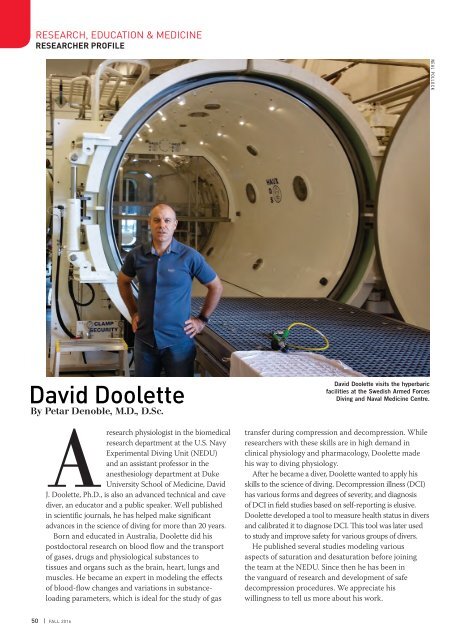AD 2016 Q4
Alert Diver is the dive industry’s leading publication. Featuring DAN’s core content of dive safety, research, education and medical information, each issue is a must-read reference, archived and shared by passionate scuba enthusiasts. In addition, Alert Diver showcases fascinating dive destinations and marine environmental topics through images from the world’s greatest underwater photographers and stories from the most experienced and eloquent dive journalists in the business.
Alert Diver is the dive industry’s leading publication. Featuring DAN’s core content of dive safety, research, education and medical information, each issue is a must-read reference, archived and shared by passionate scuba enthusiasts. In addition, Alert Diver showcases fascinating dive destinations and marine environmental topics through images from the world’s greatest underwater photographers and stories from the most experienced and eloquent dive journalists in the business.
You also want an ePaper? Increase the reach of your titles
YUMPU automatically turns print PDFs into web optimized ePapers that Google loves.
RESEARCH, EDUCATION & MEDICINE<br />
RESEARCHER PROFILE<br />
NEAL POLLOCK<br />
David Doolette<br />
By Petar Denoble, M.D., D.Sc.<br />
Aresearch physiologist in the biomedical<br />
research department at the U.S. Navy<br />
Experimental Diving Unit (NEDU)<br />
and an assistant professor in the<br />
anesthesiology department at Duke<br />
University School of Medicine, David<br />
J. Doolette, Ph.D., is also an advanced technical and cave<br />
diver, an educator and a public speaker. Well published<br />
in scientific journals, he has helped make significant<br />
advances in the science of diving for more than 20 years.<br />
Born and educated in Australia, Doolette did his<br />
postdoctoral research on blood flow and the transport<br />
of gases, drugs and physiological substances to<br />
tissues and organs such as the brain, heart, lungs and<br />
muscles. He became an expert in modeling the effects<br />
of blood-flow changes and variations in substanceloading<br />
parameters, which is ideal for the study of gas<br />
David Doolette visits the hyperbaric<br />
facilities at the Swedish Armed Forces<br />
Diving and Naval Medicine Centre.<br />
transfer during compression and decompression. While<br />
researchers with these skills are in high demand in<br />
clinical physiology and pharmacology, Doolette made<br />
his way to diving physiology.<br />
After he became a diver, Doolette wanted to apply his<br />
skills to the science of diving. Decompression illness (DCI)<br />
has various forms and degrees of severity, and diagnosis<br />
of DCI in field studies based on self-reporting is elusive.<br />
Doolette developed a tool to measure health status in divers<br />
and calibrated it to diagnose DCI. This tool was later used<br />
to study and improve safety for various groups of divers.<br />
He published several studies modeling various<br />
aspects of saturation and desaturation before joining<br />
the team at the NEDU. Since then he has been in<br />
the vanguard of research and development of safe<br />
decompression procedures. We appreciate his<br />
willingness to tell us more about his work.<br />
50 | FALL <strong>2016</strong>










